The Portuguese maritime superiority was being challenged by other European nations by the early 17
th Century. In 1600, Queen Elizabeth of England gave a charter for the English East India Company to trade in India. In 1602, the Dutch formed the Dutch East India Company VOC(VEREENIGDE OOSTINDICHE COMPAGNIE) under a Charter. It may be the first international Company to sell stocks of the Company. It was also given quasi-governmental powers. First established in present-day Indonesia, with its headquarters in Batavia or current-day Jakarta, they spread their wings of trade in Asia, Africa and the Americas.
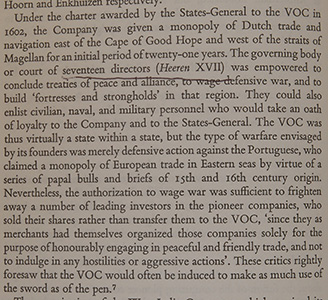 Formation Of VOC by merchants for 'honourable trade' and not war.
Formation Of VOC by merchants for 'honourable trade' and not war.
The Dutch captured all the Portuguese possessions in Ceylon in 1656-58. In 1660, they took Quilon for a brief period though it was retaken by the Portuguese. The Malabar Princes could appreciate the changes that were occurring. In 1661, the Dutch, under the command of Van der Meyden appeared at the Vaipin coast in Cochin. He was welcomed by the Mutha Thavazhy Princes of Cochin, the Raja of Cranganore, and the Zamorin of Calicut. While proceeding along the coast, they took control of Azhikotta. However, since the weather was unreasonable they entrusted the captured territory to the Zamorin and returned to Ceylon. In addition to the Princes welcoming the Dutch, it was remarkable that Paliath Komi Achan, who served the Vettath Raja of Cochin at that time, concluded a treaty with Admiral Rikloff Van Goen to aid and support the Dutch. He made it clear that the Mutha Thavazhi was the legitimate contender for the throne of Cochin. The Jews of Cochin also were supportive of the Mutha Thavazhi Princes.
The Council in Batavia at Jakarta approved the campaign on the West Coast. In January 1662, Admiral Van Goen returned with a large force. He had already taken Quilon. He advanced to Cranganore and with the help of the Zamorin, the Raja of Cranganore and the Paliath Achan defeated the Portuguese who fought valiantly. Next, the Dutch landed at Vaipin and attacked Cochin from the south. The Mutha Thavazhy Prince joined Van Goen on board the ship. They marched to Mattanchery and waged a fierce battle close to the Palace and the Pagoda, and defeated the Vettath faction. The Raja and two of his brothers were killed. Goda Varma was the only surviving Vettath Prince. He was at Palluruthy and after hearing about the disaster at Mattanchery, crossed over to Arur to recruit an army. Hendrick Van Rheede was entrusted to save the old Rani. She was spotted at the Pagoda and was carried to safety with the help of two Namboodiris, to Admiral Van Goen’s Camp. The Mutha Thavazhi Raja prostrated himself before his aunt, the Rani, and begged fo her fogiveness.
Continued Dutch progress was impeded by the renewed vigour of a reinforced Portuguese cauldron with the support of the Raja of Porakad and his army. The Raja of Porakad had been an ally of the Portuguese and the Vettath faction all along. The losses on both sides were great. The Dutch had to retreat. This was cause enough for the Vettath faction to rejoice and plunder.
The Jews and the Konkinis were special targets in Mattanchery. Goda Varma returned with a contingent of Nayars and made a triumphant entry. The Mutha Thavazhi Raja and Paliath Achan escaped from Mattanchery. Another monsoon came and ended. Not hearing from the Dutch, the Raja and Achan proceeded to Colombo. On the 26th of October, 1662, a large fleet under the command of Jacob Hustaart appeared before Cochin. This fleet was enjoined by Van Goen’s forces from Batavia. Unfortunately, the Mutha Thavazhi Raja died on the board, bequeathing the Kingdom to his brother, Veera Kerala Varma.
The Dutch systematically took control of Mattanchery, crossed over to Ernakulum and after a pitched battle and slaughter proceeded to Fort Cochin. After several days of intense fighting, the Portuguese capitulated : 'By the terms of the capitulation, all the Portuguese possessions in Cochin passed over to the Dutch, all the married Portuguese and Mestizos were sent to Goa and the unmarried ones to Europe, all free Topasses and Canarians were left at the disposal of the Dutch Commander.'
Veera Kerala Varma of Mutha Thavazhy (1663 -1687)
Prince Veera Kerala Varma was installed as the King of Cochin by General Hustaart. He was presented with a crown bearing the arms of the Dutch East India Company. A treaty was concluded on the 22nd of March, 1663. The Dutch was to protect Cochin from all foreign aggression, to erect fortresses for protection and the Raja was to deliver to the Dutch, all the pepper and cinnamon produced in the country and allow them the monopoly of importing opium. Paliath Achan was confirmed as the Minister in Chief. The Raja of Porakad re-established the alliance with the Raja of Cochin and the Dutch.
To paraphrase V.K.R. Menon from the booklet ‘COCHIN’ – ' The Civil war in Cochin enabled the Dutch to get a footing in Malabar. On the 8th of January, 1663, they captured Fort Cochin. It was their principal possession in Malabar for the next 132 years. Trade was the primary motive in prompting them to this step; trade continued to be their chief motive throughout their stay at Cochin. The Batavian Council had decided by 16 votes to 1 that those interracial marriages are to be considered taboo. The Dutch carried about them, the chilly atmosphere of the North Sea, and the sensitive Indians who had, at heart, a lingering affection for the swash-buckling ‘Parangi’, shunned their company instinctively. They were able administrators and their elaborate system was later on copied by the British. As historians, they were far ahead of their boastful predecessors. Some of the memoirs left behind by successive Commandeurs of Cochin are ideal examples of clear thinking, dispassionate analysis, and terse expression. Some of the highest encomiums to the Cochin Raja and the Cochin Ruling Family were paid for by the Commandeurs themselves even when they were not on speaking terms with the Raja.'
Some Cochin historians have suggested that the Dutch claimed all the rights of as the Suzerains and Overlords over the Raja of Cochin and his feudatories. The Dutch records, however, tell a different tale. Hendrick Adrian Van Rheede, the famous Commandeur of Cochin from 1672 to 1677, writes the following in his celebrated 'MEMOIR' - 'Cochin Raja is the noblest Prince in Malabar. He is a mighty chief of peoples, lands and allies. If the Raja thankfully accepts the help of the Company and makes use of it properly, and the Company is wise enough to unite its power and friendship with that of the Raja, so that he will be powerful enough to keep his extensive territories under control, then would there be no power in India, in water or in land, which could do damage to this combination; and all the Malabar Rajas should look up to him.' Van Rheede’s dream was never realized as Batavia was there for trade with profits.
Van Rheede’s 'Memoir' was very insightful. He was the first Dutch administrator of the State of Cochin. The Portuguese called the person holding this post, the 'Regedore Major'. The day-to-day events were administered by this man. He was in close contact with Raja Veera Kerala Varma and was fond of him. He dedicated the volume three of the Hortus Malabaricus to the Raja. However, he realized that the Raja was ill-prepared to rule and it was unfortunate that the throne fell in his lap when his elder brother died. Vera Kerala Varma never disguised from Van Rheede that he disliked governing and his own interest was in meditation and study. The Cochin Kingdom under his helm was no match to the Zamorin of Calicut and the discord amongst the other Princes and the disloyalty of the vassals added to the instability. His interest in the religious matters and the money he spent on temples and related charities irked Van Rheede greatly. The latter wrote in a letter in 1673 about an episode where the Raja requested considerable amount of money for a pagoda in Trichur. Van Rheede questioned the expense involved. The Raja professed that it was a greater honour for the King of Cochin to be a supporter of pagodas and temples than to be rich in money. The Raja was also unlucky because his personal advisor was a devious canarin merchant namely Perimbala.
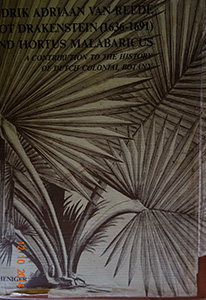
Hendrik A, Van Reede, HORTUS MALABARICUS

Van Reede writes about Raja Vera kerala Varma -
a man who did not relish being King

And prefered to focus on temple and prayers
He writes about the Namboodiris who were his colleagues in the royal council.- “Namboodiri or priests are Malabar Brahmins. Some of them have no other occupation but the temple service, and are exempt from all worldly cares, constantly occupied by heathen wisdom, star-gazing and natural science. They are very good and sober people, living a godly and modest life, and they drink no other beverage but water, honey, milk and butter. Among them there are also many who serve at the royal courts, both as councillors and as envoys to their neighbours, either in peace or in war, and to whom the most important affairs of government and prosperity are entrusted, as well as the education of the children of all the principal kings and lords. These people are pleasant to associate with, at least for those who know them and are able to adapt themselves a little to their way of life, for their mastery and wisdom at the same time render them arrogant”. ref: Van Rheede’s memorandum of 1676
Hugo K. s’ Jacob’s authoritative book titled the “
THE RAJAS of COCHIN 1663-1720” give a valuable perspective formed on the basis of VOC papers in old Dutch translated by the author. During Vera Kerala Varma’s reign and probably even prior to that, two other communities the Konkinis and Pattars seem to have influenced the Raja more than the Namboodiris. One of them was Perimbala, a Konkani merchant with great influence on the Raja. This alienated the Princes and caused great worry as regards to their matrilineal succession itself. A younger brother of the Raja was the heir apparent. The next in line was Rama Varma of Cranganore, who had been adopted strangely against the tradition. Moreover he was also a strong Zamorin supporter. The fourth Prince was Goda Varma of Mutha Thavazhi. Van Rheede probably understood the power relations in Cochin more than the rest of the Dutch administrators. When he returned as commander of Malabar in 1670, he took several measures to strengthen Cochin so as to prevent expansion of the Zamorin. In 1671, he organized a council of state consisting of six regional rulers including the Paliath Achan. This council was to advise the Raja and supervise the finances of Cochin. This was also to curb the influence of Perimbala over the Raja. Lands were farmed out for tobacco cultivation in Mouton (Chertala) to the Topazes who were the Malabar Portuguese Christians. This was to raise revenue for the Dutch. Raja did the same at the insistence of Perimbala to raise his revenue. This was displeased the Chiefs of Mouton and Kurunad, the second and fourth Prince as well as the Paliath Achan. Dutch called it the Union of Mouton. Van Rheede joined this alliance. The local chiefs promised help to the Dutch and the Company in return offered to support their traditional rights. He forced the Raja to join the union and thus alienate Perimbala. However, the Konkani took advantage of a feud between Van Rheede and Van Goens. Van Rheede tried to maintain the truce between Zamorin and Cochin even though territories once belonged to Cochin was held by Zamorin as a result of help provided against the Vettath faction. Vera Kerala Varma considered it his duty to reconquer these territories. Perimbala corresponded with Vosburgh who was close to Van Goen and all sorts of rumours were spread against Van Rheede. To provoke a war Nayars of Muriyanattu Nambiar, Rama Varma of Cranganore and Perimbala attacked the Mapranam fort. Heavy concerted pressure from the Company, Paliath Achan and the other Princes of Cochin, Vera Kerala Varma agreed to renew the truce with Zamorin. A new treaty was signed in 1678. The Cochin Princes were excluded from the government and Paliath Achan was asked to manage the finances of Cochin. The Raja’s treasury was depleted and the Royal paraphernalia had been pawned.
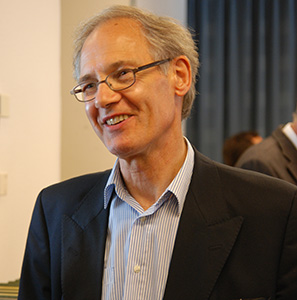
Dr. Hugo K.s' Jacob, Author
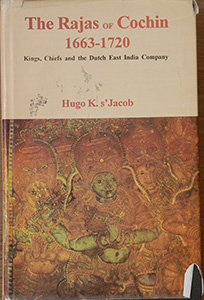
Archives of Dutch VOC.
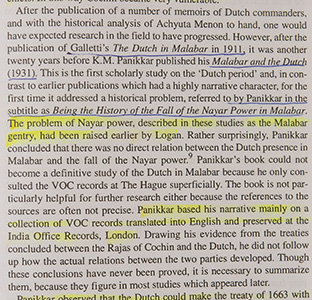
Author suggests that Kerala Historian
K.M Panikkar lacked full access to the
complete VOC records.
Van Goens sent his protégé Marten Huijsman as Commissioner and Commander of Malabar in 1678. Huijsman soon realized that the debt was not recoverable. He suggested re-organization. The management of the lands to the north and south was entrusted to Paliath Achan, Hendrick Reijinst, the Talachanavar of Chowgat and the Manakotta Achan. The management of Cochin was left to Wittula Nayak. Any one of them could be dismissed only jointly by the Raja and the Commissioner. At the end of 1682, Perimbala was still influencing the Raja, both the Paliath Achans had died and Huijsman realized that he had only blank Olas of the treaty!
Gelmer Vosburgh, who belonged to the Van Goen faction, replaced Huijsman as commander supported the Raja and Perimbala against the Mouton union. In 1687, Vera Kerala Varma died at Trichur. His brother the second Prince Ravi Varma became the Raja. He also inherited a debt of 166,461 fanams owed to the Dutch. In addition he also needed 150,000 fanams for the death ceremonies of his brother. The new commander was Van Dielen recommended by Van Rheede. Van Dielen was sympathetic to the plight of the new Raja and promised to support Cochin with all available means.
There were three issues the Dutch wanted to negotiate, the policy towards Zamorin, adoption of Princes to the Cochin kingdom and the influence of the canarin merchants in the affairs of Cochin. Dutch was in favour of a co-operative existence with Zamorin because of earlier treaties. However, Cochin territories were under the control of Zamorin and Cochin was unwilling to co operate. The Vettath faction was clamouring for war or at least an amicable settlement. Goda Varma of Vettath living in Goa with Portuguese protection and support from various chieftains in Cochin was gearing up for another revolt and Dutch wanted to avoid this. Paliath Achan and some of the Madambis were with the Dutch. Perimbala’s successor Canaga Pattar who was the Raja’s advisor secretly aspired for the Vettath succession. These were chaotic times with several political factions vying for control.
The Chazhiyur branch was the only surviving Thavazhi from the Perumpadappu Swaroopam. In September of 1689, Raja Ravi Varma, the only surviving member of the Mutha Thavazhi, decided to adopt from the Chazhiyur branch several Princes and few Princesses. This was after Van Dielen’s insistence. He had gone to Tripunithura where Raja was visiting the temple to draft a succession agreement. There is indication that the chief priest of the Tripunithura temple intervened in favour of the Dutch. By this time, the Vettath faction was gaining ground and many of the local Rajas and hereditary chiefs were aligning with the faction against the Mutha and Chazhiyur Princes. The Paliath Achan and a few of his supporters stood with the Dutch. Perimbala and Canaga Pattar also joined the Vettath faction. In a surprise attack under the command of Van Rheede who had returned as Commissary –General aided by the Nayars of Paliath Achan and the Zamorin, the Vettath faction was routed and the palaces and houses of the chiefs and Rajas who were supporting the Vettath faction were burned down. In the process, Dutch ceded Chetuva to the Zamorin against the wishes of the Raja as a treaty obligation. Raja Ravi Varma who was a weak Raja died in Thiruvalla in 1698.
Rama Varma of Chazhiyur adoption ascended the throne. He was more interested in mourning rituals and in keeping control over the temple at Thiruvalla. This Raja died in Irinjalakuda in 1702 giving succession to another adoptee from Chazhiyur carried out in 1689. He was Rama Varma.
Rama Varma from Chazhiyur Thavazhy who ruled from 1702 to 1721.
He was strong, resolute and ambitious. He was dissatisfied with the lack of assistance from the Dutch against the Zamorin and the rebellious regional chiefs within the realm of Cochin. He wrote letters to the Governor General of Batavia. In the meantime, frequent skirmishes were taking place between the Nayars of Zamorin and the northern landlords of Cochin. Finally the Zamorin declared war against Cochin. This obligated the Dutch to field an army against Zamorin, something they had avoided for the last 40 years. The Rajas of Porakad, Vadakkancoor and other feudatories of Cochin joined in the effort. The war was terminated in 1710 with a treaty signed by which Chetuva and Cranganore came back to the control of the Dutch and Cochin. However several bits of territory still remained with the Zamorin.
Zamorin by a clever move aligned with an Englishman Robert Adams in a surprising attack took over the Chetuva fort. Final success came only after re-enforcements came from Batavia under William Bakker Jacobz. In 1718, Zamorin had to cede to the Dutch Chetuva Island, Mapranam and other tracts of land possessed by him. Raja Rama Varma was now satisfied that he had recovered most of the lands once in possession of his ancestors.
Hugo K. s’Jacob made the following observations about Raja Rama Varma. His policy during his reign was to exploit the Dutch by making available a large Dutch force. He was not a puppet in the hands of the Dutch. The complaints of the Dutch regarding Rama Varma show that he had his own policy. Dutch could not manipulate him. After many a weak Rajas, Raja Rama Varma had attained the ambition of his predecessor Vera Kerala Varma, embodied in the 1663 treaty with the Dutch.

Rajas of Cochin..page 77. Civil war in Cochin over Vettath succession

Rajas of Cochin..page 170.
Hugo Jacob gives insight also into the adoption of Princes and Princesses which took place in the 1712-15 periods. After Rama Varma the successor Prince had leprosy. The third and fourth were involved in violence and blackmail. This necessitated fresh adoption and hence two Princes and two Princesses were nominated from Chazhiyur and solemnized.
Raja Rama Varma died in Trichur on the 9th October 1722. His nephew Ravi Varma succeeded. He was a man of little or no judgment. Nothing of importance occurred during his reign. The prime-minister Ittinikumaran Achan, who was haughty and arrogant and got involved in some high handed actions including murder, was ultimately sacked. After his death, his successor Ittinnan Achan effected reconciliation with the Raja. The Raja died in Irinjalakuda in 1731. The next Raja was Rama Varma who was depicted as a mild benevolent king liked by all who lived a simple life. Stein Van Gollenesse in his memoir describes him as “dull, grasping and fickle” but “good natured”. His reign coincided with the rise of Travancore.
Rise of Travancore
An excellent account is given by C. Achyutha Menon in his authoritative COCHIN STATE MANUAL. Detailed Travancore history of this period has been covered by De Lennoy in his book “KULASEKHARA PERUMALS of TRAVANCORE”. The following summation will be based on these two great works. At the end of the reign of the last Perumal one of the main Swaroopams that resulted was Venad Swaroopam situated at the southernmost part of Kerala. This entity consisted of Venad proper, Attingal, Desinganad (Singnatty), and Elayadathunad. These territories were ruled by weak Princes for long and were being overpowered by the feudal lords and other refractory chiefs. With the help of the Nayak of Madura and to some extent by the British trading post in Attingal the famous King Marthanda Varma literally extirpated the feudal power base. He was to form a greater Travancore. He amalgamated Attingal, Desinganad and Elayadathunad in quick succession. Next he turned against Kayamkulam. This brought in the Dutch to battle. Travancore with a well-trained standing army and battle ready soldiers inflicted a great loss on the Dutch. The Dutch had asked for help from the Raja of Cochin. He was conflicted because of the fact that there has been no precedent of war between these two States. Yet the Raja sent a detachment of Nayars to help the Dutch. The war was concluded by a treaty of peace between Travancore and Dutch. Dutch was banned from helping any state including the ones they had treaty obligations, in case Travancore attacked them. The Dutch retained Cochin for almost fifty more years but they were no longer effective in the Malabar Politics.
The neutrality of Dutch cleared the way for the invading Marthanda Varma to capture Porakad in 1748 and Thekkankur in 1750 and arrive at the frontiers of Cochin. The reigning Raja Rama Varma had died in Kurikad in 1746. His brother Vera Kerala Varma ruled for four years and in 1750 was succeeded by his nephew Rama Varma. At this time the plight of Cochin was literally between two fires. A ruthless dictator with a well-trained battle hardened army on one side and Zamorin always looking for an opportunity with loyal support of his feudal chiefs ready to pounce from the other side.
Raja Rama Varma was much younger than some of the Chazhiyur Thampan Family members. There was an age old custom that the Perumpadappu Moopil status was given to the oldest male member of the Family. The Portuguese had discontinued this custom way back when Unni Rama Koil was the Raja. When Mutha Thavazhi took over in 1663 under the Dutch, this tradition was honoured. However Raja Rama Varma who carried out the last adoption in 1715 wanted to move away from the old tradition and settled the issue by negotiation with the Chazhiyur Thampans. He had given enough wealth to the Thampans in his settlement. But in 1750, the issue resurfaced and the Thampans wanted Marthanda Varma to mediate. The Travancore army easily marched to Karappuram, revived the title of Perumpadappu Moopil and asked the Thampans to administer the territory as a feudatory of Travancore.
In 1753, ratification of the Dutch – Travancore treaty took place in Mavelikkara. The Raja of Cochin also attended the conference. He was disappointed at the outcome and walked out with added enmity. The chiefs of Vadakkancoor and Porakad applied for Cochin help to free themselves from the Travancore yoke. A large number of Nayars assembled in Mattanchery and Palluruthy, joined by Paliath Achan’s forces. Dissatisfied soldiers from Kayamkulam and other states annexed by Travancore finally landed in Porakad by boat. Travancore army was expecting it and waited under the leadership of Prince Rama Varma, Ramayyan Dalawa, and Captain D’Lannoy. After an initial advantage gained by the Cochin army, with the introduction of Travancore cavalry, the Cochin army was decisively beaten and their leaders taken prisoners. After this victory, Ramayyan’s army advanced through Cochin all the way to Arukutty. Prince Rama Varma advanced to Udayanperur in the south and Mamala in the west. At this point Raja of Cochin sued for peace.
COCHIN - TRAVANCORE TREATY
One of the prisoners was the young Komi Achan of Paliath. He created an impression on the young Prince Rama Varma of Travancore and a kind of unreasonable friend- ship developed. Young Achan was counselled in various ways. He was set free and when he came back he was ready to advise the King of Cochin for the need to negotiate with the mighty Travancore. The Dutch also could not be persuaded to go against Travancore. Achan succeeded in inducing Marthanda Varma and his nephew to visit Tripunithura and the Raja of Cochin to negotiate a treaty of perpetual friendship and mutual support in future. Raja of Cochin naturally insisted on territory conquered by Travancore to be vacated. This broke up the negotiation. Later, in Suchindrum in Travancore basically the same treaty was signed. This was dated 22nd January 1757. ref
While Travancore was expanding in 1755-57, Zamorin started encroaching from the north. He defeated the Rajas of Valluvanad and Palghat, took control of Chetuva and progressed on various fronts and took control of most of Cochin except the Kanayannur Taluk and parts of the Trichur Taluk. Many of the Cochin chiefs and naduvazhis accepted Zamorin’s control. Paliath Achan, Cheranellur Kartha and the Anjikaimals alone stuck with the Raja of Cochin. Minimal skirmishes between the Cochin Nayars and the Nayars of Zamorin continued. Even the Dutch fought against the Zamorin in Madilakam. However the Dutch withdrew its support of Cochin when the Zamorin returned Chetuva to Dutch control. Zamorin who had stayed in Trichur for five years died in 1759.
In august 1760, Raja died in Mattanchery. His successor Vera Kerala Varma sent Komi Achan to Trivandrum. Elaborate plans were made with Travancore and incorporated in a fresh treaty. Travancore was to help Cochin to recover most of her territories from Zamorin and Cochin should let Travancore keep Alangad and Parur considered as tributaries of Cochin. It is noteworthy that the local Dutch authorities tried hard to prevent this treaty being signed. In late January of 1762, two divisions of Travancore army assembled in Ernakulum. One division was led by Dalawa Marthanda Pillai and the other division was under General D’Lannoy. They were joined by the Cochin army. The division under D’Lannoy proceeded to Alangad and Parur and Marthanda Pillai’s division moved to Mapranam and Cranganore. No resistance was offered in Alangad and Parur as the Zamorin’s forces had retreated to Cranganore. Marthanda Pillai’s men fell on the Zamorin’s men in Mapranam and pursued them to Trichur. In Trichur the Zamorin’s army was also attacked from the rear by a regiment from Kavalappara and Perattuvithi with the result that the Zamorin’s army had to retreat to Kunnamkulam and Chelakkara. In the meantime, D’Lannoy division defeated the invaders in Cranganore, liberated Chetuva and proceeded to Trichur via Enamakal and hooked up with Marthanda Pillai’s forces. The combined forces advanced to Chelakkara and then to Kunnamkulam and all the way to Ponnani and beyond. By this time all the Cochin frontiers had been freed. D’Lannoy wanted to continue on. However, Zamorin sued for peace. Multiple treaties were signed and honoured by all the parties involved. At D’Lannoy’s suggestion with full participation of both Rajas ‘Nedumkotta’ became a reality in due course to protect both Travancore and Cochin.
Marthanda Varma’s role was an eye opener to Cochin. He had to fight the feudal power with decisive dictatorial power. He had to resort to violent means to achieve dictatorial power. His enemies were willing to resort to violent means which justified him to wield even more violence and terror. Once he was successful in consolidating the Venad Swaroopam, sheer ambition and power hunger propelled him to invade and dominate the neighbouring kingdoms and in the process created Travancore. But in Cochin, the Rajas very seldom embraced power. The Raja was a creation of the feudal landlords. The Rajas depended on the advisors who acted on behalf of the feudal powers. From the very beginning, their role has been to try to hold on to ‘Sanathanadharma’ ( a religious and spiritual way of life). Only Unni Goda Varma Koil Thirumalpad, the Raja who welcomed the Portuguese and later Raja Rama Varma who ruled from 1702 to 1722 (when the Dutch were in power) exerted any kind of determination and valour in a dictatorial mode. Even this may be attributed to dire situation where the very survival of Cochin as an entity was at stake.
After the conclusion of the last war with Zamorin, all the powers vested in feudal chiefs were taken away and were placed in the hands of officers selected by the Raja. The feudal chiefs had to relinquish their holdings in writing. This swelled the ‘Pandaravaka’ or state properties. New system of administration replacing the feudal system, as was introduced by Marthanda Varma was adopted in Cochin also. Kovilakathumvathukkals were administered by Kariakars who exercised judicial and executive functions. The prime minister was the Valia Sarvadhy Kariakar. The king became more powerful. The influence of the Raja of Travancore, Rama Varma, who was the successor to Marthanda Varma, was significant.
There was a tactless Dutch Governor who got involved in inciting trouble, but both the Rajas co-operated and wrote to Batavia with the effect that the Governor C.L. Senff was called back and in his place Adrian Van Moens was appointed. He proved to be very friendly to Cochin.









